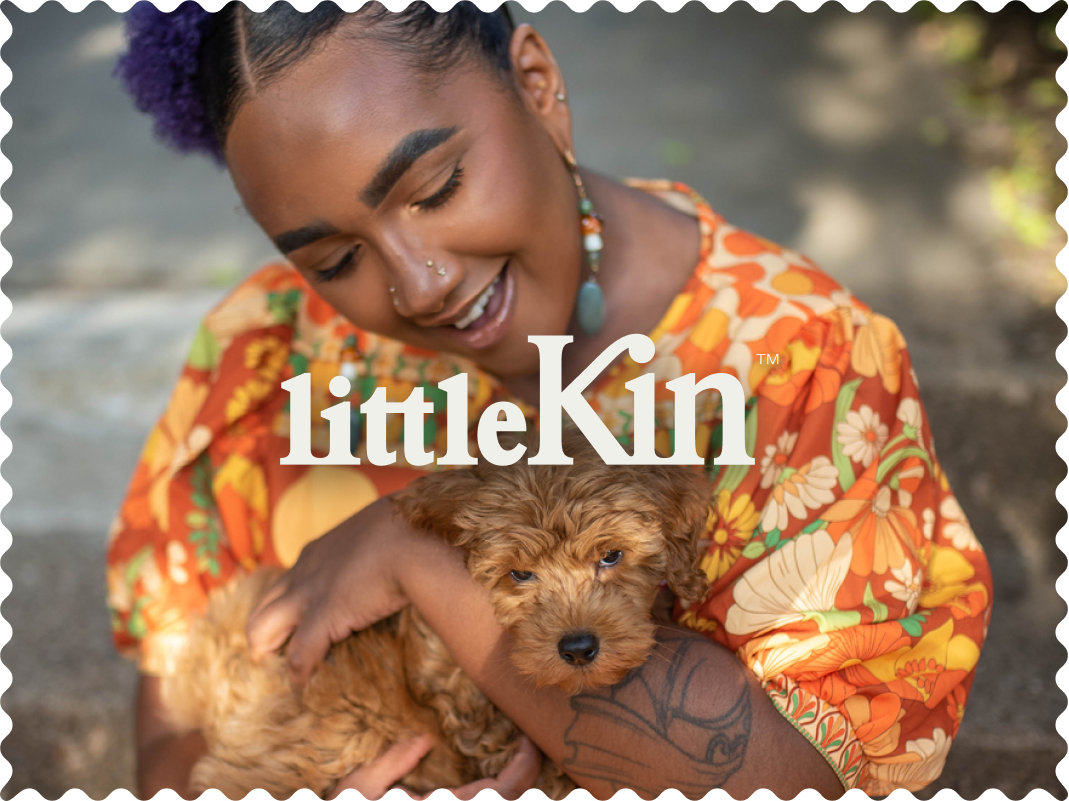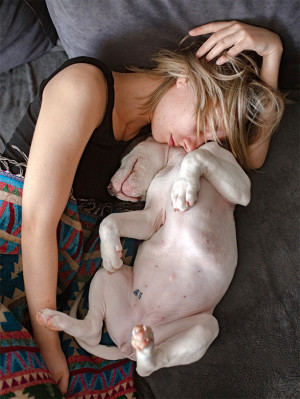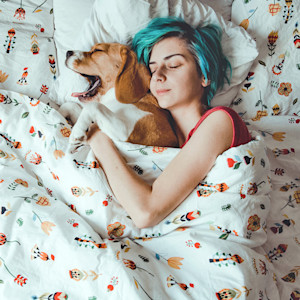Why Does My Dog Cry in Their Sleep?
Learn about the causes and what to do.

Share Article
In This Article:
Dog Sleep Cycles Causes of Dogs Crying In Their Sleep What to Do If Your Dog is Crying in Their Sleep When to Be Concerned
You’re curled up on the couch, binge-watching your favorite series, when suddenly you hear a faint whimper. You glance over and see your dog, paws twitching, breathing faster, and softly crying in their sleep. Your heart sinks. Are they having a nightmare? Are they in pain? Should you wake them up?
Just like humans, dogs are complex dreamers. They snore, twitch, growl, and sometimes cry while they sleep. But is this behavior normal or a sign of something more serious? Let’s dig into the dreamy world of dog sleep to find out what’s going on behind those fluttering eyelids.
Dog sleep cycles
Dogs sleep more than we do — on average, 12 to 14 hours daily. Puppies, senior dogs, and large breeds, like English Mastiffs and Rottweilers, sleep even longer. However, their sleep time isn’t about laziness; it’s how they rest, recharge, and process the world around them.
How much do you spend on your pet per year?

Like humans, dogs go through different stages of sleep, including light sleep, REM (rapid eye movement), and deep sleep. REM sleep is where the magic happens. This is when your dog’s brain activity increases and when they’re most likely to dream. You’ll often see their paws twitching, eyelids fluttering, tails wagging, or hear them making soft noises, sometimes even full-on barks or cries. This stage usually starts 20 minutes into a sleep cycle, lasting a few minutes at a time. Because dogs cycle through REM more frequently than humans, you may see and hear odd behaviors multiple times in one nap.
Dogs’ sleep cycles are shorter and lighter than ours. They tend to wake easily, often nap throughout the day, and react to subtle noises. This is an evolutionary trait that kept wild dogs and wolves alert to danger.
Overall, a dog’s sleep is more dynamic and active than it looks. While most sleep behaviors are normal, understanding the rhythm of dog sleep can help you tell the difference between harmless dream twitching and something that may need closer attention, like seizures or underlying discomfort.
Causes of dogs crying in their sleep
If you’ve ever heard your dog softly crying or whining while they snooze, it can be surprisingly emotional. It’s easy to imagine they’re having a sad dream or feeling pain, and sometimes, that might not be far from the truth. Understanding why dogs cry in their sleep helps you spot what’s normal and what’s not.
Below are some of the most common reasons.
Dreaming or having a nightmare: Dogs experience dreams during the REM (Rapid Eye Movement) stage of sleep, just like humans. Dogs process memories, emotions, and experiences while they sleep. So, if your dog spends the day chasing squirrels, playing at the puppy park, or dealing with a stressful situation, those events may resurface during REM sleep. That’s one reason why dogs may cry, twitch, or vocalize in their sleep; they’re reliving those moments again in their dreams.
Whimpering, twitching, or crying can simply be part of a vivid dream, good or bad. It’s not always a nightmare. Your dog could just be excited, stimulated, or reacting emotionally to dream scenarios. Because dogs can’t describe their dreams, we rely on physical cues. If your dog seems peaceful when they wake and shows no signs of fear or anxiety, there’s probably nothing to worry about.
REM sleep behavior disorder: In rare cases, dogs may suffer from REM Sleep Behavior Disorder (RBD), a neurological condition where the muscles don’t remain relaxed during REM sleep. This causes dogs to act out their dreams physically, leading to vocalizations and movements during sleep.
Unlike normal dream-related twitching, RBD episodes tend to be more intense. Dogs may leap up suddenly, snap at the air, or thrash their legs violently. This isn’t common, but if your dog’s sleep episodes appear exaggerated or dangerous to themselves or others, it’s worth bringing up with a vet or veterinary neurologist.
Seizure disorder: One of the more concerning possibilities behind sleep crying is seizures. Certain types of seizures, like focal seizures or those related to epilepsy, can occur during sleep. These might mimic dreaming behavior, such as twitching, paddling, or vocalizing, but often appear more rigid or repetitive.
Unlike dreams, seizures don’t typically involve gradual transitions. They can happen suddenly and may cause your dog to seem dazed or confused upon waking. Some dogs will also drool excessively, lose control of their bowels, or appear disoriented after the event.
If you suspect your dog is having seizures in their sleep, try to record a video of the behavior and consult your veterinarian as soon as possible. Diagnosis might involve neurological exams or blood work, and treatment may include anti-seizure medications.
Anxiety: Dogs with anxiety, whether generalized, situational, or trauma-based, may exhibit restless sleep and emotional vocalizations. A dog who feels insecure, is going through changes in routine, or has a history of abandonment or abuse may carry those feelings into sleep. While their crying may resemble a dream or nightmare, the emotional root is often much deeper. Dogs with anxiety may also sleep less soundly overall, be hyper-attuned to sounds while asleep, or wake up suddenly in a panic.
Providing a stable routine, safe sleep space, and calming tools like white noise machines or pheromone diffusers can help anxious dogs settle into more peaceful sleep. In moderate to severe cases, your vet may suggest training interventions or anxiety-reducing medications.
Illness: Sometimes, the reason your dog cries during sleep has nothing to do with what’s going on in their head; it’s all about their body. Pain, inflammation, or internal discomfort can disrupt your dog’s ability to rest.
Arthritis, hip dysplasia, digestive issues, and dental pain can make certain sleeping positions uncomfortable. Dogs in pain may not fully wake up to reposition themselves, resulting in vocalizations while still dozing. Illnesses that cause fever or nausea may also produce restless, vocal sleep.
If your dog shows signs of discomfort such as limping, loss of appetite, stiffness, or changes in behavior, it’s worth investigating the physical cause behind the nighttime distress.
What to do if your dog is crying in their sleep
Hearing your dog cry in their sleep tugs at the heartstrings, but it can also raise questions about what’s safe and helpful for them at that moment.
Should you wake your dog?
In most cases, the answer is no. Just like with people, suddenly waking a dog from REM sleep can be disorienting or even alarming. If your dog is simply dreaming, waking them up might interrupt a natural process and leave them confused.
There’s also a risk of a defensive reaction. A sleeping dog, especially one startled awake, might instinctively nip, growl, or bolt — not out of aggression, but out of fear. If your dog seems deeply distressed or the vocalizations are unusually intense, gently calling their name or making a soft sound may help rouse them gradually without panic.
That said, if you strongly suspect your dog is experiencing a seizure or physical pain, a gentle wake-up followed by a calm assessment might be appropriate. Always approach slowly and with care.
How to make your dog more comfortable
Creating a cozy, safe sleep environment can significantly reduce nighttime crying. Here’s how:
Choose a consistent sleep spot. Dogs like routine. Their sleep area should be the same each night, quiet, familiar, and removed from household noise.
Add padding and warmth. Orthopedic beds, heated pads, or plush blankets can help reduce pain or discomfort, especially for older dogs.
Limit evening stress. Avoid overstimulating your dog in the hour before bed. Instead, focus on calm activities, such as gentle play, brushing, or cuddles.
Use soothing aids. Calming pheromone sprays, lavender-scented bedding, or low-volume white noise can help reduce anxiety in sensitive dogs.
Keep a journal. If sleep crying is frequent, log the time, behavior, and any daytime events that might be contributing. Patterns often emerge.
When to be concerned
Sleep crying isn’t always a red flag, but there are times when it’s worth paying closer attention to it. The occasional whimper is likely a dream, but ongoing sleep distress might be a signal of deeper issues.
Some signs that your dog’s sleep crying may not be normal:
Crying that becomes more frequent or intense over time
Crying paired with violent twitching or rigid limbs
Crying followed by confusion, disorientation, or incontinence upon waking
Behavior changes during the day such as lethargy, aggression, or appetite loss
Crying that begins suddenly in an adult or senior dog with no history of it
If you observe these signs consistently, it’s time to dig deeper.
When to consult a vet
Trust your instincts. If your dog’s sleep behavior seems off, worsens quickly, or is accompanied by other health or behavioral changes, make an appointment with your veterinarian.
Here’s when to call the vet:
You suspect seizures or neurological issues
Your dog is older and showing signs of cognitive decline
Pain, stiffness, or lameness is noticeable during the day
The crying interferes with your dog’s ability to rest or function normally
Your vet may conduct a physical exam, recommend blood tests, or refer you to a neurologist or behaviorist, depending on what they find. Often, minor sleep disturbances can be managed with better routines, more mental stimulation during the day, and calming sleep environments. When something more serious is going on, early intervention makes all the difference.
References
“Dog Seizures.” American Kennel Club, https://www.akc.org/expert-advice/health/dog-seizures/opens in new tab
“Sleep in Dogs.” VCA Animal Hospitals, https://vcahospitals.com/know-your-pet/sleep-in-dogsopens in new tab
“Understanding REM Sleep Behavior Disorder in Pets.” PetMD, https://www.petmd.com/dog/conditions/neurological/what-rem-sleep-behavior-disorder-dogsopens in new tab

Valerie Mellema
Valerie Mellema has a Bachelor of Science in Agribusiness and Equine Industry from West Texas A&M University. She has been a professional writer for the past 20 years, covering a wide variety of pet health and care topics before founding a nonprofit focused on mental health in children and thoroughbred aftercare. She has four Border Collies and eight retired racehorses.
Related articles
Why Does My Dog Twitch In Their Sleep?
Dogs twitch in their sleep for many reasons.
Why Does My Dog Sleep on Their Back?
It is so sweet...
![Woman sleeping in bed with her beagle dog.]()
Does Your Dog Get a Bad Night’s Sleep When They Share a Bed With You?
You might be stealing all the covers.
What Does Your Dog’s Sleeping Position Say About Them?
Is your pup a splooter or a donut? It turns out, you can learn a lot from how your dog snoozes.
Why Is Your Dog Barking in Their Sleep? Should You Be Concerned, or Is This Normal?
Learn the difference between when it’s cute and when it’s troubling.
Why Is Your Dog Shaking In Their Sleep? Learn If This Is Normal
We detail everything you need to know about this common dog-sleep behavior.








